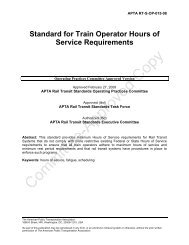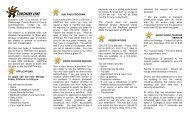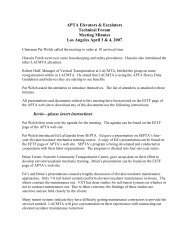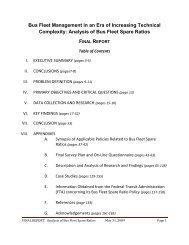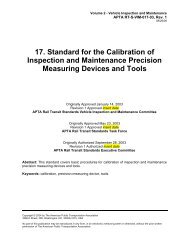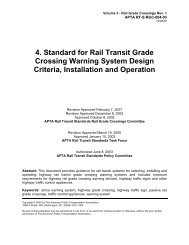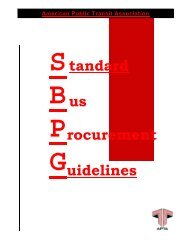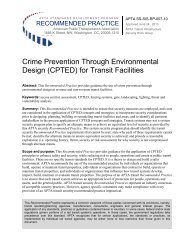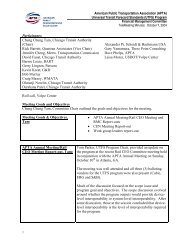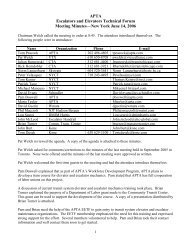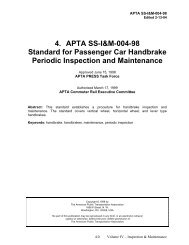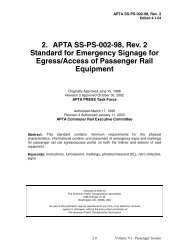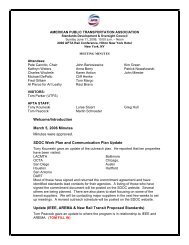4. APTA SS-PS-004-99, Rev. 1 Standard for Low-Location Exit Path ...
4. APTA SS-PS-004-99, Rev. 1 Standard for Low-Location Exit Path ...
4. APTA SS-PS-004-99, Rev. 1 Standard for Low-Location Exit Path ...
Create successful ePaper yourself
Turn your PDF publications into a flip-book with our unique Google optimized e-Paper software.
<strong>APTA</strong> <strong>SS</strong>-<strong>PS</strong>-<strong>004</strong>-<strong>99</strong>, <strong>Rev</strong>. 1<br />
Edited 4-1-04<br />
<strong>4.</strong> <strong>APTA</strong> <strong>SS</strong>-<strong>PS</strong>-<strong>004</strong>-<strong>99</strong>, <strong>Rev</strong>. 1<br />
<strong>Standard</strong> <strong>for</strong> <strong>Low</strong>-<strong>Location</strong> <strong>Exit</strong> <strong>Path</strong><br />
Marking<br />
Originally Approved May 21, 1<strong>99</strong>9<br />
<strong>Rev</strong>ised October 30, 2002<br />
<strong>APTA</strong> PRE<strong>SS</strong> Task Force<br />
Originally Authorized October 9, 1<strong>99</strong>9<br />
<strong>Rev</strong>ision 1 Authorized January 11, 2003<br />
<strong>APTA</strong> Commuter Rail Executive Committee<br />
Abstract: This standard contains minimum requirements <strong>for</strong> an emergency low-location<br />
exit path marking system (LLEPM) <strong>for</strong> new, remanufactured, and existing rail passenger<br />
cars using passive (non-electrically illuminated) and/or active (electrically illuminated)<br />
means of marking the exit path(s) to safety.<br />
Keywords: emergency exit, exit path, low-location exit path marking system (LLEPM)<br />
Copyright © 2002 by<br />
The American Public Transportation Association<br />
1666 K Street, N. W.<br />
Washington, DC, 20006, USA<br />
No part of this publication may be reproduced in any <strong>for</strong>m, in an electronic retrieval<br />
system or otherwise, without the prior written permission of<br />
The American Public Transportation Association.<br />
<strong>4.</strong>0<br />
Volume VI - Passenger System
Introduction<br />
<strong>4.</strong>1<br />
<strong>APTA</strong> <strong>SS</strong>-<strong>PS</strong>-<strong>004</strong>-<strong>99</strong>, <strong>Rev</strong>. 1<br />
Edited 4-1-04<br />
(This introduction is not a part of <strong>APTA</strong> <strong>SS</strong>-<strong>PS</strong>-<strong>004</strong>-<strong>99</strong>, <strong>Rev</strong>. 1, <strong>Standard</strong> <strong>for</strong> <strong>Low</strong>-<br />
<strong>Location</strong> <strong>Exit</strong> <strong>Path</strong> Marking.)<br />
<strong>Rev</strong>iew of past passenger rail accidents involving passenger and train crew emergency<br />
evacuation has indicated that both passengers and emergency responders lacked<br />
sufficient in<strong>for</strong>mation necessary <strong>for</strong> expedient emergency egress and access due to the<br />
absence of clear markings and instructions. The lack of adequate signage in conjunction<br />
with lighting system failures and/or low levels of illumination during these accidents<br />
were cited as a cause <strong>for</strong> confusion and as a contributing factor to the injuries and<br />
casualties that resulted.<br />
The National Transportation Safety Board (NTSB) made the following recommendation<br />
to the Federal Railroad Administration (FRA) in National Transportation Safety Board<br />
Recommendation to Federal Railroad Administration, FRA R-97-17 after investigation of<br />
a recent passenger train accident:<br />
“Issue interim standards <strong>for</strong> the use of luminescent material, retroreflective<br />
material, or both to mark all interior and exterior emergency exits in all passenger<br />
cars as soon as possible and incorporate the interim standards into minimum car<br />
standards.”<br />
FRA issued a final rule revising existing glazing standards contained in 49 CFR, Part 223<br />
and established minimum standards <strong>for</strong> emergency preparedness (see 49 CFR, Part 239).<br />
The FRA regulations require that minimum levels of emergency lighting be provided near<br />
doors and along the aisles be <strong>for</strong> new cars. In addition, <strong>for</strong> both new and existing cars, the<br />
interior location of each passenger car door used <strong>for</strong> emergency egress must be marked<br />
and be conspicuously visible by the use of lighting and/or luminescent marking. Each<br />
door control release mechanism must be marked on the interior and exterior with clearly<br />
visible and legible instructions. The interior location of emergency exit windows must<br />
also be clearly visible by the use of luminescent material and instructions <strong>for</strong> their use<br />
must be also be provided. If exterior window access points are provided to emergency<br />
responders, clear and conspicuous markings and instructions must be provided.<br />
This standard establishes requirements <strong>for</strong> LLEPM which will provide visual guidance<br />
<strong>for</strong> emergency rail car evacuation when smoke conditions obscure overhead emergency<br />
lighting or when failure of the emergency lighting system has occurred<br />
This standard, taken together with the American Public Transportation Association<br />
(<strong>APTA</strong>) <strong>APTA</strong> <strong>SS</strong>-E-013-<strong>99</strong>, <strong>Standard</strong> <strong>for</strong> Emergency Lighting System Design <strong>for</strong><br />
Passenger Cars, and <strong>APTA</strong> <strong>SS</strong> <strong>PS</strong>-002-98, <strong>Rev</strong> 2, <strong>Standard</strong> <strong>for</strong> Emergency Signage <strong>for</strong><br />
Egress/Access of Passenger Rail Equipment 1 , provides a systems approach to locate,<br />
reach, and operate emergency exits to ensure the safe evacuation of passengers and<br />
crewmembers in the event of an emergency. Railroads and car builders should carefully<br />
consider the options available to meet emergency evacuation requirements presented in<br />
these three standards.<br />
1 For references in Italics, see Section 2 of this <strong>Standard</strong>.<br />
Volume VI - Passenger System
<strong>APTA</strong> <strong>SS</strong>-<strong>PS</strong>-<strong>004</strong>-<strong>99</strong>, <strong>Rev</strong>. 1<br />
Edited 4-1-04<br />
This revision of the <strong>Standard</strong> contains a reorganized section 1 (to include scope);<br />
renumbered Reference section (now 2) and addition of 49 CFR regulations, and ASTM<br />
and UL standards as references. One definition (marking) was added and abbreviations<br />
and acronyms are now included in Section 3. Section 6 headings were revised, material<br />
safety is now a separate section 7, and the remaining sections are renumbered.<br />
In addition, the bibliography was moved to Annex A, and the in<strong>for</strong>mation <strong>for</strong>merly<br />
contained in Annex A was expanded upon (now included in Annex D), and two new<br />
annexes were added to provide railroads with extensive guidance <strong>for</strong> ensuring that the<br />
passive LLEPM material required by this standard provides the minimum brightness<br />
specified herein.<br />
<strong>4.</strong>2<br />
Volume VI - Passenger System
Participants<br />
<strong>4.</strong>3<br />
<strong>APTA</strong> <strong>SS</strong>-<strong>PS</strong>-<strong>004</strong>-<strong>99</strong>, <strong>Rev</strong>. 1<br />
Edited 4-1-04<br />
The American Public Transportation Association (<strong>APTA</strong>) greatly appreciates the<br />
contributions of the following individual(s), who provided the primary ef<strong>for</strong>t in the<br />
drafting of the <strong>Standard</strong> <strong>for</strong> <strong>Low</strong>-<strong>Location</strong> <strong>Exit</strong> <strong>Path</strong> Marking:<br />
Doug Karan<br />
In addition, <strong>APTA</strong> would like to thank the following members from the Volpe Center <strong>for</strong><br />
their extensive technical research and assistance in the preparation of this document,<br />
specifically:<br />
Stephanie Markos J.K. Pollard<br />
At the time that this standard was completed, the Passenger Rail Equipment Safety<br />
<strong>Standard</strong>s (PRE<strong>SS</strong>) Passenger Systems Committee included the following members:<br />
Dave Brooks<br />
Ralph Dolinger<br />
Robert Gagne<br />
Bret A. George<br />
Doug Karan<br />
John Kopke<br />
Eric Kosty<br />
Billy Lopez<br />
Bill Lydon, Chair<br />
Susan Madigan<br />
Stephanie Markos<br />
Jim Michel<br />
Brenda Moscoso<br />
Scott Ornstein<br />
J. K. Pollard<br />
Al Pucci<br />
Jack Reidy<br />
Volume VI - Passenger System
Contents<br />
<strong>4.</strong>4<br />
<strong>APTA</strong> <strong>SS</strong>-<strong>PS</strong>-<strong>004</strong>-<strong>99</strong>, <strong>Rev</strong>. 1<br />
Edited 4-1-04<br />
1. Overview...................................................................................................................... <strong>4.</strong>5<br />
1.1 Scope...................................................................................................................... <strong>4.</strong>5<br />
1.2 Purpose................................................................................................................... <strong>4.</strong>5<br />
2. References.................................................................................................................... <strong>4.</strong>6<br />
3. Definitions, abbreviations, and acronyms.................................................................... <strong>4.</strong>6<br />
3.1 Definitions ............................................................................................................. <strong>4.</strong>6<br />
3.2 Abbreviations and acronyms ................................................................................. <strong>4.</strong>8<br />
<strong>4.</strong> General system requirements....................................................................................... <strong>4.</strong>8<br />
5. System design requirements ........................................................................................ <strong>4.</strong>9<br />
5.1 Passive marking method (HPPL)........................................................................... <strong>4.</strong>9<br />
5.2 Active marking methods...................................................................................... <strong>4.</strong>10<br />
5.3 LLEPM exit door markings ................................................................................. <strong>4.</strong>12<br />
5.4 LLEPM exit door sign ......................................................................................... <strong>4.</strong>12<br />
6. Material safety ........................................................................................................... <strong>4.</strong>12<br />
7. System reliability ...................................................................................................... <strong>4.</strong>12<br />
8. Operating conditions................................................................................................. <strong>4.</strong>12<br />
9. Maintenance.............................................................................................................. <strong>4.</strong>13<br />
Annex A (in<strong>for</strong>mative) Bibliography ............................................................................ <strong>4.</strong>14<br />
Annex B (in<strong>for</strong>mative) Passive LLEPM luminance lab test and criteria ...................... <strong>4.</strong>16<br />
Annex C (in<strong>for</strong>mative) Test laboratories ....................................................................... <strong>4.</strong>17<br />
C.1 ASTM............................................................................................................. <strong>4.</strong>17<br />
C.2 Underwriters’ Laboratories (UL) ................................................................... <strong>4.</strong>18<br />
C.3 Deutche industrie norm (DIN) ....................................................................... <strong>4.</strong>18<br />
Annex D (in<strong>for</strong>mative) Passive LLEPM field test and criteria ..................................... <strong>4.</strong>19<br />
D.1 Technical Considerations............................................................................... <strong>4.</strong>19<br />
D.2 Verification of compliance options................................................................ <strong>4.</strong>20<br />
D.3 Alternatives to increase light output .............................................................. <strong>4.</strong>22<br />
Volume VI - Passenger System
<strong>APTA</strong> <strong>SS</strong>-<strong>PS</strong>-<strong>004</strong>-<strong>99</strong>, <strong>Rev</strong>. 1<br />
Edited 4-1-04<br />
<strong>APTA</strong> <strong>SS</strong>-<strong>PS</strong>-<strong>004</strong>-<strong>99</strong>, <strong>Rev</strong>. 1<br />
<strong>Standard</strong> <strong>for</strong> <strong>Low</strong>-<strong>Location</strong> <strong>Exit</strong> <strong>Path</strong> Marking<br />
1. Overview<br />
Historically, passenger rail car accidents and incidents have occurred resulting in fire<br />
and/or smoke-filled car/compartment conditions. In the presence of these conditions, the<br />
difficulty of evacuating passengers and/or crewmembers may increase substantially.<br />
Because smoke generally rises, illumination from conventional emergency lighting<br />
fixtures, operating as intended, may be obscured. Additionally, in the event of an<br />
accident/incident, failure of the main back-up power system may occur. In these<br />
situations, the most viable escape path is most visible at or near the floor.<br />
This standard requires that each rail passenger car shall have a low-location emergency<br />
exit path marking system, visible in the area from the floor to a plane 4 feet (1.22 m)<br />
above the aisle of the rail car. This low-location exit path marking system (LLEPM),<br />
located in the relatively clear air near the rail car floor, shall enable passengers and<br />
crewmembers to visually identify the path to exit the rail car in an emergency.<br />
If an alternate means of achieving compliance with this standard are sought to be<br />
employed, a hearing must be requested from an equivalency review committee (ERC)<br />
and the alternative method must be documented, demonstrated and determined to be<br />
sufficient to meet the equivalency criteria established by the ERC.<br />
1.1 Scope<br />
This standard shall apply to all new and remanufactured passenger and crew carrying<br />
equipment placed in service after January 1, 2000. All existing equipment must be in<br />
compliance with this standard by January 1, 2006. Cars in procurement as of the effective<br />
date of this standard shall be considered existing equipment.<br />
EXCEPTION--Equipment that fails to meet minimum emergency lighting levels<br />
established in <strong>APTA</strong> <strong>SS</strong>-E-013-<strong>99</strong>, <strong>Standard</strong> <strong>for</strong> the General Emergency Lighting System<br />
Design <strong>for</strong> Passenger Cars 2 , shall be in compliance by July 1, 2002.<br />
1.2 Purpose<br />
This standard establishes requirements <strong>for</strong> LLEPM which will provide visual guidance<br />
<strong>for</strong> emergency rail car evacuation when smoke conditions obscure overhead emergency<br />
lighting or when failure of the emergency lighting system has occurred.<br />
2 For references in Italics, see Section 2.<br />
<strong>4.</strong>5<br />
Volume VI - Passenger System
2. References<br />
<strong>4.</strong>6<br />
<strong>APTA</strong> <strong>SS</strong>-<strong>PS</strong>-<strong>004</strong>-<strong>99</strong>, <strong>Rev</strong>. 1<br />
Edited 4-1-04<br />
This standard shall be used in conjunction with the following publications. When the<br />
following publications are superceded by an approved revision the revision shall apply.<br />
<strong>APTA</strong> <strong>SS</strong>-C&S-012-02, <strong>Standard</strong> <strong>for</strong> Passenger Car Door Systems <strong>for</strong> New and Rebuilt<br />
Passenger Cars.<br />
<strong>APTA</strong> <strong>SS</strong>-E-013-<strong>99</strong>, <strong>Standard</strong> <strong>for</strong> Emergency Lighting System Design <strong>for</strong> Passenger<br />
Cars.<br />
<strong>APTA</strong> <strong>SS</strong>-I&M-005-98, <strong>Rev</strong>. 2, Passenger Compartment Periodic Inspection and<br />
Maintenance.<br />
<strong>APTA</strong> <strong>SS</strong>-I&M-008-98, <strong>Rev</strong>. 1, Electrical Periodic Inspection and Maintenance.<br />
<strong>APTA</strong> <strong>SS</strong>-<strong>PS</strong>-002-98, <strong>Rev</strong>. 2, <strong>Standard</strong> <strong>for</strong> Emergency Signage <strong>for</strong> Egress/Access of<br />
Passenger Rail Equipment.<br />
ASTM E 2073-02, <strong>Standard</strong> Test Method <strong>for</strong> Photopic Luminance of Photoluminescent<br />
(Phosphorescent) Markings.<br />
49 CFR, Part 223, Glazing.<br />
49 CFR, Part 238, Passenger Equipment Safety <strong>Standard</strong>s.<br />
49 CFR, Part 239, Passenger Equipment Train Emergency Preparedness<br />
3. Definitions, abbreviations, and acronyms<br />
3.1 Definitions<br />
For the purposes of this standard, the following terms and definitions apply:<br />
3.1.1 active illumination: Illumination, which is generated by electrical energy.<br />
3.1.2 aisle: A path through a vehicle that is not bordered by walls, such as the path<br />
through the center of a coach car with rows of seats on each side.<br />
3.1.3 candela: unit of luminous intensity in both SI and English measurement systems.<br />
One candela is one lumen per steradian (lm/sr). It is almost exactly equal to the obsolete<br />
unit called the candle.<br />
3.1.4 electroluminescent (EL): Luminescence resulting from the application of an<br />
alternating electrical current to phosphor.<br />
3.1.5 equivalency review committee (ERC): An adjudicatory committee comprised of<br />
representatives from <strong>APTA</strong> and appropriate industry subject matter experts to evaluate<br />
Volume VI - Passenger System
<strong>APTA</strong> <strong>SS</strong>-<strong>PS</strong>-<strong>004</strong>-<strong>99</strong>, <strong>Rev</strong>. 1<br />
Edited 4-1-04<br />
the equivalent attainment of Passenger Rail Equipment Safety <strong>Standard</strong>s (PRE<strong>SS</strong>)<br />
promulgated standards through alternative methods.<br />
3.1.6 exit path: The path or corridor through a rail car that provides the preferred path of<br />
evacuation from the car.<br />
3.1.7 externally illuminated: The light source is located outside of the device, legend,<br />
or path to be illuminated. The light source is typically fluorescent, incandescent or a<br />
dedicated fluorescent or incandescent source.<br />
3.1.8 high per<strong>for</strong>mance photoluminescent material (HPPL): A material that is<br />
capable of emitting fluorescent and/or phosphorescent light at a high rate and <strong>for</strong> an<br />
extended period of time after absorption of light radiation from an external source by the<br />
process of photon excitation.<br />
NOTE--These materials shall be charged at 5 foot-candles (fc) <strong>for</strong> 1 hour. The measured value<br />
shall be a minimum of not less that 7.5 mcd/m 2 (milli-candela per square meter) after 1.5 hours.<br />
(See Annexes B-D)<br />
3.1.9 illuminance: The amount of light (luminous flux) falling on a specific area or<br />
surface. English units are foot-candles (fc) or lumens per sq. foot (Lm/ft 2 ). International<br />
(SI) units are lumen per sq. meter (Lm/m 2 ) or lux (lx).<br />
3.1.10 internally illuminated: The light source is contained inside the device or legend<br />
that is illuminated. The light source is typically incandescent, fluorescent,<br />
electroluminescent, light-emitting diode (LED), or self-illuminating.<br />
3.1.11 low-location: Area of the rail car defined by a volume whose horizontal plane<br />
includes the entire area of the floor and extending upwards a distance of four (4) feet<br />
(1.22 m).<br />
3.1.12 luminance: The amount of light reflected from an area or surface or the amount<br />
of light emitted from a surface, e.g., electroluminescent or light-emitting diode (LED)<br />
material. English units are foot-lamberts (fl). International (SI) units are candela per<br />
square meter (cd/ m 2 ) and milli-candella per square meter (mcd/m 2 ). (1 fl = 3.426 cd/m 2<br />
or 3426 mcd/ m 2 .)<br />
3.1.13 luminescence: The emission of light other than incandescent, as in<br />
phosphorescence or fluorescence by processes that derive energy from essentially nonthermal<br />
sources through excitation by radiation.<br />
3.1.14 marking: A visible notice, sign, symbol, line or trace.<br />
3.1.15 passageway: A path through a vehicle that is bordered by walls to allow a<br />
passenger or crew the ability to move from one place to another.<br />
3.1.16 Passive illumination: Illumination that is generated without the use of electrical<br />
energy.<br />
<strong>4.</strong>7<br />
Volume VI - Passenger System
<strong>APTA</strong> <strong>SS</strong>-<strong>PS</strong>-<strong>004</strong>-<strong>99</strong>, <strong>Rev</strong>. 1<br />
Edited 4-1-04<br />
3.1.17 photoluminescent (PL): Having the property of emitting light that continues <strong>for</strong><br />
a length of time after excitation by visible or invisible light has been removed (i.e., selfilluminating.)<br />
3.1.18 primary exit: The normal (preferred) exit point of passengers and crewmembers<br />
from the affected car in an emergency to an adjacent car located at either end of the<br />
affected car.<br />
3.2 Abbreviations and acronyms<br />
CFR Code of Federal Regulations<br />
DIN Deutsche Industrie Norm<br />
EL electroluminescent<br />
ERC equivalency review committee<br />
FAA Federal Aviation Administration<br />
HPPL high per<strong>for</strong>mance photoluminescent material<br />
IMO International Marine Organization<br />
LED light-emitting diode<br />
LLEPM low-location exit path marking<br />
PL photoluminescent<br />
PRE<strong>SS</strong> Passenger Rail Equipment Safety <strong>Standard</strong>s<br />
<strong>4.</strong> General system requirements<br />
The LLEPM system must provide evacuation guidance <strong>for</strong> passengers and crewmembers<br />
when normal and emergency sources of illumination are obscured or inoperative. It must<br />
be active, or become active, immediately and automatically upon loss of normal and<br />
emergency lighting power. <strong>Low</strong>-location markings must be visible within a volume as<br />
defined in Section 3.1.10. The system must enable passengers to visually identify the<br />
escape path to all primary exits in at least two directions. In cars with only one available<br />
primary exit (e.g., when end doors are locked or secured), additional measures shall be<br />
taken to direct passengers to an alternative door exit or provide emergency door opening<br />
instructions <strong>for</strong> the secured primary exit.<br />
The low-location marking system shall be composed of three elements:<br />
– <strong>Exit</strong> path marking materials/fixtures<br />
– <strong>Exit</strong> door marking materials<br />
– <strong>Exit</strong> door signage marking materials/fixtures<br />
The LLEPM system must be independent of the rail car’s normal and emergency lighting<br />
systems and must become immediately visible when the car’s normal and emergency<br />
electrical power ceases to operate. This system shall clearly outline the path to the rail<br />
car’s primary exits, which shall be marked in accordance with <strong>APTA</strong> <strong>SS</strong>-<strong>PS</strong>-002-98, <strong>Rev</strong>.<br />
2, <strong>Standard</strong> <strong>for</strong> Emergency Signage <strong>for</strong> Egress/Access of Rail Passenger Equipment.<br />
LLEPM system requirements are as follows:<br />
<strong>4.</strong>8<br />
Volume VI - Passenger System
<strong>APTA</strong> <strong>SS</strong>-<strong>PS</strong>-<strong>004</strong>-<strong>99</strong>, <strong>Rev</strong>. 1<br />
Edited 4-1-04<br />
a) Shall be visible and provide emergency evacuation guidance <strong>for</strong> passengers under<br />
all operating conditions <strong>for</strong> a period of 1.5 hours after all normal and emergency<br />
lighting has ceased operation;<br />
b) Shall provide an easily distinguishable path along the floor from all aisle seating<br />
and compartment locations in the rail car to all of the car’s primary exits;<br />
c) Shall include exit signs at each primary exit visible from a low-location (as<br />
defined in 3.1.10) and from a horizontal distance of 6 feet (1.93 m) from the exit<br />
along the exit path;<br />
d) Shall provide readily distinguishable markings along the perimeter of the door or<br />
door frame visible from a low-location (as defined in 3.1.10) and from a<br />
horizontal distance of 6 feet (1.93 m) from the exit along the exit path;<br />
e) Shall provide readily distinguishable markings on or around the door’s operating<br />
handle.<br />
Providing the above conditions are met, the LLEPM system may consist of either passive<br />
(HPPL) marking materials, active (electrical) marking fixtures, or a combination of these<br />
two systems.<br />
5. System design requirements<br />
The LLEPM shall identify an easy-to-follow exit path from all aisle and compartment<br />
seating positions to the primary exits through the cars center aisle, side aisle,<br />
passageway, and stairs. The LLEPM system shall consist of either passive (HPPL)<br />
marking materials, active (electrical) marking fixtures, or a combination of these two<br />
systems.<br />
5.1 Passive marking method (HPPL)<br />
When using HPPL marking materials as exit path marking material in rail cars, an<br />
ambient light source must be available, (either natural and/or artificial), to provide a<br />
sufficient charge to the HPPL system prior to the loss of the main lighting power and<br />
emergency power systems. Annexes B and D provide the lab and field tests necessary to<br />
demonstrate that the LLEPM meets the criteria <strong>for</strong> light output of 7.5 mcd/m 2 after 1.5<br />
hours.<br />
HPPL marking material may be applied on the floor or upon seat pedestals/components at<br />
a height of not more than 18 inches (45.7 cm) from the floor on both sides, (unless<br />
applied as a continuous strip on the floor, in which case, the LLEPM material need only<br />
be applied to one side or down the middle of the aisle/passageway). The marking material<br />
shall be oriented to insure that it is easily visible to passengers and crewmembers<br />
negotiating the aisle/passageway and adequately exposed to the charging light fixtures<br />
and/or natural light source.<br />
The width of each marking strip shall not be less than 1 inch (2.54 cm) and may be<br />
applied either as a continuous or intermittent strip with no uncovered interval exceeding<br />
<strong>4.</strong>9<br />
Volume VI - Passenger System
<strong>APTA</strong> <strong>SS</strong>-<strong>PS</strong>-<strong>004</strong>-<strong>99</strong>, <strong>Rev</strong>. 1<br />
Edited 4-1-04<br />
36 inches (91 cm) in length. The marking material must be positioned to be readily<br />
recognized as a continuous path from any seat or compartment in the car to all of the<br />
primary exits.<br />
The spacing between the corner of a change in direction of the exit path and the marking<br />
material shall not exceed 4 inches (10 cm).<br />
EXCEPTION--The maximum spacing of the marking materials may exceed 36 inches<br />
(91 cm) if the marking system is determined to provide equivalent visual delineation of<br />
the exit path.<br />
In all stairways HPPL marking material shall be applied either as a continuous strip<br />
applied on the partitions of both sides of the stairs or as intermittent strips applied to the<br />
treads and risers of each step.<br />
When the HPPL marking material is applied to the stairway partitions the marking shall<br />
be applied as a continuous strip extending from the lowest to the highest step. Each strip<br />
shall be a minimum of 1 inch (2.54 cm) wide and be located no higher on the partition<br />
than 18 inches (45.7 cm) above the stair nosing.<br />
When the HPPL marking material is applied to the stairway treads and risers a 1 inch<br />
(2.54 cm) wide strip of material shall extend across the full width of each tread and riser<br />
near the step nosing.<br />
5.2 Active marking methods<br />
5.2.1 Strip marking materials<br />
In lieu of, or in addition to, HPPL materials, incandescent electroluminescent (EL), and<br />
LED marking material/fixtures may be employed as LLEPM material. The luminance<br />
value of the incandescent, EL, or LED marking material/fixtures as measured at the<br />
active areas shall be not less than 1000 mcd/m 2 . The incandescent, EL, or LED marking<br />
system shall be independent of the car’s normal and emergency lighting systems and be<br />
operational <strong>for</strong> a period of 1.5 hours after all normal and emergency lighting has ceased<br />
operating. Incandescent, EL, or LED marking material/fixtures may be applied on the<br />
floor or upon seat pedestals/components at a height that is no more than 18 inches (45.7<br />
cm) from the floor on at least one side of the aisle/passageway. The marking material<br />
shall be oriented to insure that it is easily visible to passengers and crewmembers<br />
negotiating the aisle/passageway.<br />
The marking material/fixtures may be applied either as a continuous or intermittent strip<br />
with no uncovered interval exceeding 36 inches (91 cm) in length. The marking<br />
material/fixtures must be positioned so as to be readily recognizable as a continuous path<br />
from any seat or compartment in the car to all of the primary exits.<br />
The spacing between the corner of a change in direction of the exit path and the marking<br />
material/fixture shall not exceed 4 inches (10 cm).<br />
<strong>4.</strong>10<br />
Volume VI - Passenger System
<strong>APTA</strong> <strong>SS</strong>-<strong>PS</strong>-<strong>004</strong>-<strong>99</strong>, <strong>Rev</strong>. 1<br />
Edited 4-1-04<br />
EXCEPTION--The maximum spacing of the marking materials may exceed 36 inches<br />
(91 cm) if the marking system is determined to provide equivalent visual delineation of<br />
the exit path.<br />
In stairways incandescent, EL, or LED marking material shall be applied either as a<br />
continuous strip applied on the partitions of at least one side of the stairs or as<br />
intermittent strips applied to the treads of each step.<br />
When the marking material is applied to the stairway partitions, the marking shall be<br />
applied as a continuous strip extending from the lowest to the highest step. The strip shall<br />
be located no higher on the partition than 18 inches (45.7 cm) above the plane of the stair<br />
nosing.<br />
When the marking material is applied to the stairway treads it shall extend across the full<br />
width of each tread near the step nosing.<br />
5.2.2 Other active marking methods<br />
In lieu of, or in addition to, HPPL materials, electrically illuminated marking methods<br />
using lighting fixtures may be employed as LLEPM material on all cars. Fixtures may be<br />
mounted on partitions or seat pedestals. These marking systems may include<br />
incandescent or fluorescent lighting fixtures. The lighting fixtures must be independent of<br />
the car’s normal and emergency lighting system and be operational <strong>for</strong> a period of 1.5<br />
hours after all normal and emergency lighting has ceased operating.<br />
The partition or pedestal-mounted internally illuminated lighting fixtures may be applied<br />
at a height of up to 18 inches (45.7 cm) above the floor on at least one side of the<br />
aisle/passageway and shall be applied at intervals not to exceed 36 inches (91 cm)<br />
between fixtures.<br />
In stairways, partition-mounted lighting fixtures shall be installed on at least one side of<br />
the stairway. A lighting fixture shall be installed at each step tread and be located no<br />
more than 18 inches (45.7 cm) above the tread.<br />
The illuminance value of the lighting fixtures shall provide an average illumination value<br />
of at least 0.1 fc measured and averaged at intervals of 30 inches (76 cm) or less along<br />
the center of the aisle, passageway, or stairs. The measurements shall be taken 1.5 hours<br />
after normal lighting has ceased operating with all ambient light obscured.<br />
The spacing between the corner of a change in direction of the exit path and the marking<br />
material/fixture shall not exceed 4 inches (10 cm).<br />
EXCEPTION--The maximum spacing of the marking materials may exceed 36 inches<br />
(91 cm) if the marking system is determined to provide equivalent visual delineation of<br />
the exit path.<br />
<strong>4.</strong>11<br />
Volume VI - Passenger System
5.3 LLEPM exit door markings<br />
<strong>4.</strong>12<br />
<strong>APTA</strong> <strong>SS</strong>-<strong>PS</strong>-<strong>004</strong>-<strong>99</strong>, <strong>Rev</strong>. 1<br />
Edited 4-1-04<br />
All primary exit doors shall be clearly delineated with HPPL marking material. A<br />
minimum of 1-inch (2.54 cm) wide strips shall be applied to both sides of the exit doors<br />
or door frames and shall extend from the floor to a minimum height of 12 inches (30 cm)<br />
above the floor.<br />
Additionally each door handle, latch, or operating button shall be identified using one of<br />
the following two methods:<br />
1) Each door handle, latch, or operating button shall be identifiable using 1 inch<br />
(2.54 cm) wide outline stripping around the perimeter of the opening device.<br />
2) Each door handle, latch, or operating button shall be identifiable using an area<br />
wide pad that is no less than 6 square inches (39 sq. cm) applied to the door or<br />
door frame directly behind the handle or latch.<br />
5.4 LLEPM exit door sign<br />
All primary exit doors shall be clearly marked with an exit sign located on or<br />
immediately adjacent to each door that is no more than 18 inches (45.7 cm) above the<br />
floor as measured from the floor to the top of the sign. The LLEPM door exit sign may be<br />
HPPL material, incandescent, fluorescent, EL, or LED fixtures. The text and color<br />
requirements shall be in compliance with <strong>APTA</strong> <strong>SS</strong>-<strong>PS</strong>-002-98, <strong>Rev</strong>. 2 3 relative to exit<br />
door markings.<br />
6. Material safety<br />
Materials used in the manufacture of LLEPM products shall not contain radioactive or<br />
toxic materials.<br />
7. System reliability<br />
All LLEPM systems shall be designed so that the exit path shall not be rendered<br />
indistinguishable due to the failure of any single HPPL material segment, lighting strip,<br />
light fixture, or battery.<br />
8. Operating conditions<br />
All LLEPM systems shall be designed to operate without failure under the conditions<br />
typically found in passenger rail equipment. These conditions shall include expected<br />
mechanical vibrations and shock, electromagnetic interference, and other criteria as<br />
identified in 49 CFR, Part 238, Passenger Equipment Safety <strong>Standard</strong>s.<br />
3 For references in Italics, see Section 2.<br />
Volume VI - Passenger System
9. Maintenance<br />
<strong>4.</strong>13<br />
<strong>APTA</strong> <strong>SS</strong>-<strong>PS</strong>-<strong>004</strong>-<strong>99</strong>, <strong>Rev</strong>. 1<br />
Edited 4-1-04<br />
All LLEPM systems shall be visually inspected during the daily inspection to determine<br />
that the system is intact. If broken or missing components of the LLEPM system are<br />
detected, that shall be noted in accordance with railroad and Federal Railroad<br />
Administration (FRA) defect reporting procedures.<br />
A periodic inspection shall be made of the LLEPM system in compliance with the<br />
requirements in <strong>APTA</strong> <strong>SS</strong>-I&M-005-98, <strong>Rev</strong>. 2, Rail Passenger Car Periodic Inspection<br />
and Maintenance, <strong>for</strong> passive marking systems and with <strong>APTA</strong> <strong>SS</strong>-I&M-008-98, <strong>Rev</strong>. 1,<br />
Electrical Periodic Inspection and Maintenance. Record keeping shall be in accordance<br />
with railroad and FRA defect reporting procedures.<br />
The luminance, or illuminance, as appropriate, of all LLEPM system components shall be<br />
tested at least once every five years, testing a representative sampling of rail passenger<br />
cars of the same age and design to achieve a 95% confidence level. Components shall be<br />
replaced if the tested values are less than the minimum values stated herein.<br />
Record keeping shall be in accordance with federal and railroad defect reporting<br />
requirements.<br />
Volume VI - Passenger System
Annex A (in<strong>for</strong>mative)<br />
Bibliography<br />
<strong>4.</strong>14<br />
<strong>APTA</strong> <strong>SS</strong>-<strong>PS</strong>-<strong>004</strong>-<strong>99</strong>, <strong>Rev</strong>. 1<br />
Edited 4-1-04<br />
[B1] ANSI-ASQCZ 1.4, Sampling Procedures and Tables <strong>for</strong> Inspection by Attributes,<br />
1<strong>99</strong>3.<br />
[B2] <strong>APTA</strong> <strong>SS</strong>-E-012-<strong>99</strong>, Recommended Practice <strong>for</strong> Normal Lighting System Design<br />
<strong>for</strong> Passenger Cars.<br />
[B3] ASTM E 2072-02, <strong>Standard</strong> Specification <strong>for</strong> Photoluminescent (Phosphorescent)<br />
Safety Markings.<br />
[B4] ASTM E 2030-02, Guide <strong>for</strong> Recommended Uses of Photoluminescent Safety<br />
Markings.<br />
[B5] Chesterfield, B.P., Rasmussen, P.G., and Dillon, R.D. Emergency Cabin Lighting<br />
Installations: An Analysis of Ceiling- Vs <strong>Low</strong>er Cabin-Mounted Lighting During<br />
Evacuation Trials. Federal Aviation Administration. Office of Aviation Medicine. Final<br />
Report. No. FAA –AM-81-7.<br />
[B6] Demaree, J. “Examination of Aircraft Interior Emergency Lighting in a Postcrash<br />
Fire Environment.” Federal Aviation Administration, FAA Technical Center, Final<br />
Report. No. FAA-DOT/FAA/ct-82/55.<br />
[B7] Deutsche Industrie Norm (DIN) 67 510, Parts 1-4, German <strong>Standard</strong>:<br />
Phosphorescent Pigments and Products, January 1<strong>99</strong>2.<br />
[B8] Federal Aviation Administration Advisory Circular 25-812-1A, Floor Proximity<br />
Emergency Escape <strong>Path</strong> Marking, 5/22/89.<br />
[B9] Federal Aviation Administration Advisory Circular 25-812-2, Floor Proximity<br />
Emergency Escape <strong>Path</strong> Marking Systems Incorporating Photoluminescent Elements,<br />
7/24/97.<br />
[B10] Illuminating Engineering Society (IES), Lighting Handbook Reference and<br />
Applications, Chapter 29: Emergency, Safety and Security Lighting, 9 th Edition, 2000.<br />
[B11] International Marine Organization (IMO) Resolution A.752 (18), Nov. 4, 1<strong>99</strong>3,<br />
Guidelines <strong>for</strong> the Evaluation, Testing and Application of <strong>Low</strong>-<strong>Location</strong> Lighting of<br />
Passenger Ships.<br />
[B12] McLean, G.A., and C.B. Chittum. Per<strong>for</strong>mance Demonstration of Zinc Sulfide<br />
and Strontium Aluminate Photoluminescent Floor Proximity Escape <strong>Path</strong> Marking<br />
Systems. Federal Aviation Administration. Office of Aviation Medicine. Final Report.<br />
No. DOT/FAA/AM-92/2.<br />
[B13] National Fire Protection Association (NFPA) 101 Life Safety Code, 2000.<br />
Volume VI - Passenger System
<strong>APTA</strong> <strong>SS</strong>-<strong>PS</strong>-<strong>004</strong>-<strong>99</strong>, <strong>Rev</strong>. 1<br />
Edited 4-1-04<br />
[B14] Rasmussen, P.G, Chesterfield, B.P., and D.L <strong>Low</strong>rey. Readability of Self-<br />
Luminated Signs Obscured by Black Fuel-Fire Smoke, Federal Aviation Administration,<br />
Office of Aviation Medicine, Final Report. No. FAA-AM-80-13.<br />
[B15] Rasmussen, P.G., Garner, J.D., Blethrow, J.G., and D.L <strong>Low</strong>rey. Readability of<br />
Self-Luminated Signs in a Smoke Obscured Environment, Federal Aviation<br />
Administration, Office of Aviation Medicine, Final Report No. FAA-AM-79-108.<br />
[B16] UL 1<strong>99</strong>4 <strong>Standard</strong> <strong>for</strong> Safety <strong>for</strong> <strong>Low</strong> Level <strong>Path</strong> marking and Lighting Systems,<br />
Second Edition, dated January 28, 1<strong>99</strong>7, including revision as of July 11, 2001.<br />
[B17] 14 CFR, Part 25, Airworthiness <strong>Standard</strong>s, Transport Category Airplanes: Subpart<br />
D, Design and Construction, Subsection 25.812(e), Emergency Lighting.<br />
[B18] 14 CFR, Part 121, (Special Federal Aviation Regulations) Operating<br />
Requirements: Domestic, Flag, and Supplemental Operations, Subpart K, Instrument and<br />
Equipment Requirements, Subsection 121.310, Additional Emergency Equipment.<br />
[B19] 49 CFR, Part 223, Safety Glazing <strong>Standard</strong>s—Locomotives, Passenger Cars and<br />
Cabooses, Subpart B, Specific Requirements, Subsection 223.9 (d), Requirements <strong>for</strong><br />
New or Rebuilt Equipment–Marking.<br />
<strong>4.</strong>15<br />
Volume VI - Passenger System
Annex B (in<strong>for</strong>mative)<br />
Passive LLEPM luminance lab test and criteria<br />
<strong>4.</strong>16<br />
<strong>APTA</strong> <strong>SS</strong>-<strong>PS</strong>-<strong>004</strong>-<strong>99</strong>, <strong>Rev</strong>. 1<br />
Edited 4-1-04<br />
The manufacturer/supplier shall provide test reports that the passive HPPL material used<br />
<strong>for</strong> LLEPM, in the configuration to be used in the railcar, including any protective<br />
covering or layer to be used in actual installation meets the luminance level of 7.5<br />
mcd/m 2 , 1.5 hours after removal of normal and emergency power, when tested according<br />
to the provisions of ASTM E 2073-00, <strong>Standard</strong> Test Method <strong>for</strong> Photopic Luminance of<br />
Photoluminescent (Phosphorescent) Markings 4 (www.astm.org) with the following three<br />
modifications:<br />
f) Section 8.3—Activation: Activate the HPPL material with a fluorescent lamp of<br />
40W or less and a color temperature of 4100K that provides 5 fc of illumination<br />
as measured on the material surface. The activation period will be <strong>for</strong> 60 minutes.<br />
g) Section 8.4—Luminance: Measure the photopic luminance of all specimens of the<br />
HPPL material with a luminance meter as described in 5.2 after 1.5 hours +10 s.<br />
h) Section 9.1.12—The test report will include a luminance measurement after 1.5<br />
hours.<br />
At present, the only instruments known to be satisfactory <strong>for</strong> such measurements and<br />
commercially available are:<br />
– DR-2000, Gamma Scientific (see www.gamma-sci.com);<br />
– B510 photometer, LMT of Berlin (see www.lmt-berlin.de);<br />
– ERP-105, Hagner Instruments AB (see www.hagnerphotoins.u-net.com);<br />
– P-9710 Plus Contact Luminance Detector (under development), Gigahertz Optik<br />
(see www.gigahertz-optik.de/en/).<br />
NOTE--Other manufacturers may be developing appropriate instruments.<br />
4 For references in Italics, see Section 2.<br />
Volume VI - Passenger System
Annex C (in<strong>for</strong>mative)<br />
Test laboratories<br />
C.1 ASTM<br />
<strong>4.</strong>17<br />
<strong>APTA</strong> <strong>SS</strong>-<strong>PS</strong>-<strong>004</strong>-<strong>99</strong>, <strong>Rev</strong>. 1<br />
Edited 4-1-04<br />
The following test laboratories can per<strong>for</strong>m the ASTM E 2073 test as modified in Annex<br />
B:<br />
Hoffman Engineering Corporation<br />
8 Riverbend Drive<br />
P.O. Box 4430<br />
Stam<strong>for</strong>d, CT 06907-0430<br />
Tel: 203-425-8900<br />
Fax: 203-425-8910<br />
Contact: Jim Delancy<br />
www.HoffmanEngineering.com<br />
Gamma Scientific<br />
8581 Aero Drive<br />
San Diego, CA 92123<br />
Tel 858-279-8034<br />
Fax 858-576-9286<br />
Contact: Eric Nelson<br />
www.gamma-sci.com<br />
Gigahertz Optik<br />
5 Perry Way<br />
Newburyport, MA 01950-4009<br />
Tel: 978-462-1818<br />
Fax: 978-462-3677<br />
www.gigahertz-optik.com<br />
Maritime Associates Inc.<br />
PO Box 1788<br />
Crystal Bay, NV 89402<br />
Tel: 775-832-2422<br />
Fax: 775-832-2424<br />
Contact: Mr. John Allen<br />
www.marinesigns.com<br />
Volume VI - Passenger System
C.2 Underwriters’ Laboratories (UL)<br />
<strong>4.</strong>18<br />
<strong>APTA</strong> <strong>SS</strong>-<strong>PS</strong>-<strong>004</strong>-<strong>99</strong>, <strong>Rev</strong>. 1<br />
Edited 4-1-04<br />
Underwriters’ Laboratories (UL) has issued UL 1<strong>99</strong>4, <strong>Standard</strong> <strong>for</strong> the Safety of<br />
Emergency Lighting and Power Equipment [B18] 5 . UL 1<strong>99</strong>4 includes requirements <strong>for</strong><br />
photoluminescent and externally powered systems <strong>for</strong> installation on floors or on wall (at<br />
or near the floor) to provide a visual delineation of the path of egress during emergency<br />
situations.<br />
While this <strong>APTA</strong> LLEPM standard contains requirements consistent with the general<br />
concepts of UL 1<strong>99</strong>4, the UL tests and per<strong>for</strong>mance criteria are not appropriate to<br />
evaluate rail passenger car LLEPM.<br />
UL staff have indicated their interest in developing a testing and listing protocol to<br />
evaluate active and passive LLEPM systems used in rail passenger cars, based on the<br />
provisions contained in Annexes B and C of this <strong>APTA</strong> standard.<br />
C.3 Deutsche Industrie Norm (DIN)<br />
DIN 67510, German <strong>Standard</strong>: Phosphorescent Pigments and Products [B9] is currently<br />
being revised to allow <strong>for</strong> extrapolation of luminance values <strong>for</strong> any time period, e.g. 90<br />
minutes, based on data collected at only 10, 30 and 60 minutes (values subject to<br />
change). Extrapolation reduces testing time and costs. Future instruments may be offered<br />
<strong>for</strong> sale with the extrapolation function built in and provide the advantage of conducting<br />
measurements in less time at less cost. Accordingly, ASTM E 2073-00 (see Annex B),<br />
which is based on DIN 67510, may be revised. The procedures detailed in Annex D.2.2<br />
above may also be revised.<br />
5 The numbers in brackets correspond to those of the bibliography in Annex A<br />
Volume VI - Passenger System
Annex D (in<strong>for</strong>mative)<br />
Passive LLEPM field test and criteria<br />
D.1 Technical considerations<br />
There are three variables that affect the visibility of the LLEPM signs:<br />
a) Illuminance charging levels provided by ambient light<br />
b) Amount of time that the sign is exposed to light<br />
c) Type of activating light source<br />
<strong>4.</strong>19<br />
<strong>APTA</strong> <strong>SS</strong>-<strong>PS</strong>-<strong>004</strong>-<strong>99</strong>, <strong>Rev</strong>. 1<br />
Edited 4-1-04<br />
An illumination level of 5 foot-candles (fc) has been shown to provide adequate charging<br />
light <strong>for</strong> LLEPM material to meet the criterion of 7.5 mcd/m 2 in rail passenger cars, 1.5<br />
hours after normal power is removed. Adequate light <strong>for</strong> HPPL charging to meet the 7.5<br />
mcd/m 2 criterion is generally available at all locations, except directly under the seats or<br />
if there are overhangs or other obstructions that block light from reaching the LLEPM.<br />
Another variable is the available HPPL charging time. To meet the 7.5 mcd/m 2 criterion,<br />
the adequate charging time at 5 fc would be at least 30 minutes from dark storage to<br />
departure. Most HPPL materials reach saturation at about 30 minutes. The standard time<br />
<strong>for</strong> the test procedure is set at 60 minutes to make certain that all samples have reached<br />
saturation and to make the results less sensitive to small errors in the timing of<br />
measurements. While 5 fc provides adequate charging light with cool-white fluorescent<br />
lighting, warm-white fluorescent or incandescent lights are less effective at charging. If<br />
warm-white fluorescent or incandescent fixtures are used, the minimum actual charging<br />
level may need to be increased 20 to 50 per cent respectively to ensure that the charging<br />
level and time <strong>for</strong> LLEPM products is adequate.<br />
As a general rule, if the value of the ambient illuminance level (fc) at the location where<br />
the product is installed, multiplied by the number of minutes of exposure to a light source<br />
(natural or artificial), exceeds 150, then the charge is adequate.<br />
In addition, some samples of HPPL material may be more efficient than others at<br />
absorbing an ambient light charge, thus actual charging times may differ. However, It<br />
should also be noted that <strong>for</strong> the same charging time (but in locations where the<br />
illuminance on the surface of the HPPL signs is higher <strong>for</strong> the same amount of time; e.g.,<br />
20 fc <strong>for</strong> 60 minutes), the sign luminance may be only be increased by 25%.<br />
Finally, proper placement must avoid damage from cleaning.<br />
Volume VI - Passenger System
D.2 Verification of compliance options<br />
<strong>4.</strong>20<br />
<strong>APTA</strong> <strong>SS</strong>-<strong>PS</strong>-<strong>004</strong>-<strong>99</strong>, <strong>Rev</strong>. 1<br />
Edited 4-1-04<br />
Compliance with this standard is ultimately the responsibility of the railroad. One of the<br />
two options described below shall be followed by the railroad and HPPL material<br />
manufacturer/supplier to verify that the LLEPM products, as installed in their final<br />
configuration and location, meet the minimum luminance criterion of 7.5 mcd/m 2 , after<br />
1.5 hours from the removal of normal and emergency lighting,<br />
D.2.1 Illuminance<br />
To confirm that the HPPL material is installed in locations that receive adequate<br />
charging, illuminance measurements shall be taken on the surface of the material as<br />
installed in all locations (including any protective layer or cover), with an illuminance<br />
meter. Two suggested instruments that can be used to conduct the measurements are the<br />
Minolta T-10 or the Extech 401036. (Others are available from Hagner Instruments,<br />
Gigahertz Optik, and LMT-Berlin). All offer serial data outputs <strong>for</strong> logging<br />
measurements directly to a computer. The charging source shall consist of the actual light<br />
fixtures used in the car. If light diffusers are used on the fluorescent light fixtures, the<br />
measurements shall be made with the light diffusers in place. The minimum illuminance<br />
value measured directly on the surface of the LLEPM material shall be 5 fc.<br />
D.2.2 Luminance<br />
It is not expected that railroads will themselves conduct luminance measurements of the<br />
HPPL material used <strong>for</strong> LLEPM products installed in their cars due to the technical<br />
complexity of measuring the luminance per<strong>for</strong>mance. However, this option may be used<br />
by the LLEPM manufacturer/supplier, in cooperation with the railroad, to confirm that<br />
HPPL materials, as installed in their final configuration and location, meet the minimum<br />
7.5 mcd/m 2 , 1.5 hours after normal and emergency power is removed (instead of the<br />
option described in D.2.1).<br />
When a car to be tested arrives:<br />
a) When a railcar to be tested arrives, immediately place strips of gaffer’s tape or other<br />
opaque tape (duct tape cannot be used because it transmits too much light) on each<br />
installed LLEPM strip. These tape strips must prevent any ambient light from<br />
charging the signage.<br />
b) Wait at least 48 hours to begin testing (see Items D.2.2.l and D.2.2.m <strong>for</strong> correction<br />
factors).<br />
c) Prior to testing, the temperature of the railcar interior must be stabilized in the normal<br />
operating range, 77 +/- 5°F. (Cars stored outside in cold weather are likely to show<br />
seriously degraded per<strong>for</strong>mance, if they are tested be<strong>for</strong>e being warmed to normal<br />
temperatures).<br />
Volume VI - Passenger System
<strong>APTA</strong> <strong>SS</strong>-<strong>PS</strong>-<strong>004</strong>-<strong>99</strong>, <strong>Rev</strong>. 1<br />
Edited 4-1-04<br />
d) Begin the test by making the railcar interior completely dark. This may be done by<br />
placing the car in a dark area of the shop (car wash, etc.), working out-of-doors at<br />
night, or by masking all windows and doors with heavy paper. Close all doors. Make<br />
sure no other personnel will attempt to enter the car during the test procedure.<br />
e) Turn on normal interior lighting, make sure all fixtures are operating, and wait 20<br />
minutes to ensure that all tubes have reached stable operating temperatures.<br />
f) Start stopwatch and go through car quickly peeling back opaque tape. Leave about<br />
three inches in place to mark the location of each covered area.<br />
g) Be sure that emergency lighting circuits are disabled.<br />
h) Exactly 60 minutes after tape was peeled back, shut off all lighting.<br />
i) Exactly 90 minutes later (stopwatch reads 2 hours, 30 minutes), begin taking<br />
luminance readings using a luminance meter as described in Annex B, at each<br />
location previously covered by the opaque tape immediately adjacent to portion of the<br />
tape remaining. This procedure requires a two-person team: one to place the detector<br />
and call out readings, the other to write them down on a data sheet. Both persons<br />
must be equipped with small, red-filtered flashlights to see what they are doing. (Red<br />
light does not charge photoluminescent materials.) The measurements should be<br />
made in the same order that the tape was peeled back so they are all made 2 hours and<br />
30 minutes (+/-10 seconds), after the moment of peel back. With practice, a dozen<br />
measurements can be completed in less than three minutes.<br />
j) If the period that the LLEPM samples were covered by opaque tape was four days or<br />
longer and the HPPL materials are wider than the detector aperture of 1.38 inches (35<br />
mm), no adjustments to the data are necessary. Take a simple arithmetic average of<br />
the samples. If the average exceeds 7.5 mcd/m 2 , the car has passed. If these<br />
conditions are not satisfied, per<strong>for</strong>m the following corrections be<strong>for</strong>e taking the<br />
average.<br />
k) If the dimensions of the LLEPM samples to be measured are less than the luminance<br />
sensor aperture: 1.97 in. (50 mm) or 1.38 inches (35 mm), a special aperture plate<br />
should be ordered with a diameter slightly less than the width of the strips. The<br />
luminance meter manufacturer will supply a correction factor <strong>for</strong> this plate. Each<br />
reading must be multiplied by this correction factor.<br />
l) Alternatively, a correction factor can be determined <strong>for</strong> a standard aperture by<br />
calculating the ratio of its area to that of the area of HPPL material within the<br />
aperture. The equation <strong>for</strong> this trigonometric calculation is found in several standard<br />
handbooks, and Volpe staff will supply values on request <strong>for</strong> any given HPPL<br />
material width. For example, a HPPL sample of 1.3 inch (33 mm) width requires a<br />
correction factor of 1.016 <strong>for</strong> a 35 mm aperture. These correction factors assume that<br />
the detector is precisely centered on the material when the measurements are taken.<br />
Hence, it is better to order a special aperture plate so that it is easy to center the<br />
detector on the material.<br />
<strong>4.</strong>21<br />
Volume VI - Passenger System
<strong>APTA</strong> <strong>SS</strong>-<strong>PS</strong>-<strong>004</strong>-<strong>99</strong>, <strong>Rev</strong>. 1<br />
Edited 4-1-04<br />
m) The minimum darkness period to condition the HPPL material is 48 hours. If the<br />
period during which the samples are covered by opaque tape is less than four days, an<br />
additional correction is required. Subtract the values in the following table from the<br />
measured luminance value:<br />
n) Example:<br />
Covered period<br />
48 to 72 hours 0.2<br />
72 to 96 hours 0.1<br />
Greater than 96 hours 0<br />
<strong>4.</strong>22<br />
Correction value<br />
(mcd/m 2)<br />
The purpose of this correction is to compensate <strong>for</strong> the small amount of residual<br />
charge that may remain in the HPPL material from be<strong>for</strong>e the time it was covered<br />
with opaque gaffer’s tape.<br />
o) Although luminance meter averages are used to indicate that the LLEPM meet<br />
minimum criteria of 7.5 mcd/m 2 , if individual HPPL segments are noticeably less<br />
bright, or any other indication is seen that the LLEPM does not meet the criteria<br />
described in Section 5 of this standard, gaps exist between segments that are greater<br />
than 18 inches and alternative corrective actions must be taken to increase light<br />
output.<br />
D.3 Alternatives to increase light output<br />
If during the rail car interior field tests, the per<strong>for</strong>mance of the HPPL material fails to<br />
meet the criteria of illuminance of 5 fc using normal lighting or luminance of 7.5 mcd/m 2<br />
after normal power is removed <strong>for</strong> 1.5 hours as measured directly on the material surface,<br />
there are several alternative actions that can be taken to increase the HPPL light output<br />
levels:<br />
a) All of the light fixtures near the LLEPM test samples should be checked to ensure<br />
proper working order.<br />
b) Light fixtures must be clean and the diffusers not yellowed with age. Old, dirty<br />
fixtures have been measured with less than half the light output of clean ones with<br />
new diffusers.<br />
c) Fluorescent tubes should be checked to ensure they are not near the ends of their<br />
service lives, where light output drops significantly.<br />
d) Incandescent lamps or warm white tubes should be replaced with cool, white<br />
fluorescent tubes.<br />
e) Existing fluorescent tubes should be replaced with those of recent design that provide<br />
Volume VI - Passenger System
<strong>APTA</strong> <strong>SS</strong>-<strong>PS</strong>-<strong>004</strong>-<strong>99</strong>, <strong>Rev</strong>. 1<br />
Edited 4-1-04<br />
10-15% more light <strong>for</strong> the same wattage rating and double the service life.<br />
f) If the luminance per<strong>for</strong>mance criteria cannot be met after taking any of the above<br />
actions, the field tested HPPL materials must be replaced with HPPL materials that<br />
demonstrate greater per<strong>for</strong>mance than the lab test minimum criteria of 7.5 mcd/m 2 ,<br />
1.5 hours after normal power is removed. Some HPPL materials can meet the<br />
<strong>4.</strong>23<br />
Volume VI - Passenger System



